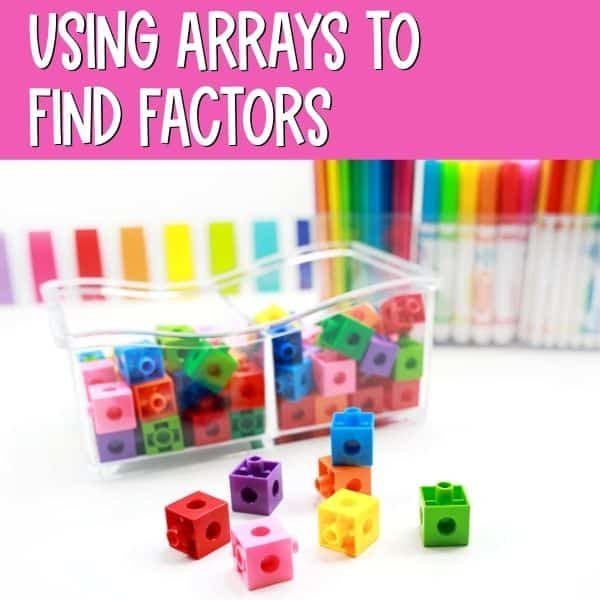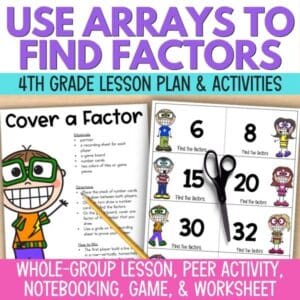Today, we’re going to explore using arrays to find factors of a given number. I’m giving you a sneak peek into how I teach this concept in my classroom in a way that keeps kids super engaged and also helps them visualize and better understand the concept of factors. Here you go!
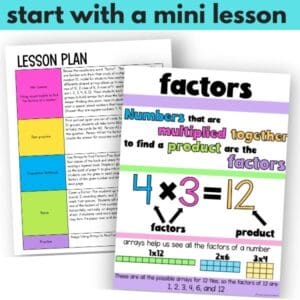
Part 1: Teach a Mini Lesson
Vocabulary Review: Factor
Before you introduce using arrays to find factors, start by reviewing the vocabulary words factor and array. These should be a familiar terms from their study of multiplication. A factor is a number that divides another number evenly. An array is a visual representation of a multiplication fact using equal numbers of rows.
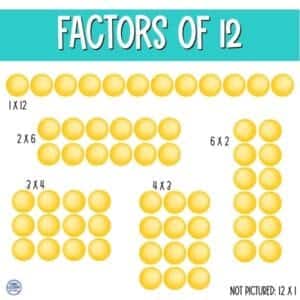
Modeling with the Number 12
Using the number 12, model for students how rearranging 12 color tiles or math cubes in different shaped arrays allows us to see the factors of 12. Here’s how to do it:
- 1 Row of 12: Show that 1 and 12 are factors.
- 2 Rows of 6: Demonstrate that 2 and 6 are factors.
- 3 Rows of 4: Illustrate that 3 and 4 are factors.
List the factors of 12: 1, 2, 3, 4, 6, and 12.
Group Activity with Color Tiles or Cubes
Have students work with color tiles in small groups using arrays to find factors of 24 and 36.
Deeper Thinking Discussion: Ask students to think and talk about what is special about numbers that have an odd number of factors. Guide them to understand that these numbers are square numbers (e.g., 4, 9, 16, 25, 36).
Part 2: Cooperative Peer Practice Activity
Print and cut apart one set of these factor cards for each group of 4 students, or make your own set by writing numbers on index cards. In groups, students will take turns filling the following roles:

- Person #1: Holds the cards for #2.
- Person #2: Chooses a card and reads the question.
- Person #3: Lists the factors of the number.
- Person #4: Checks the answer for accuracy.
This cooperative activity promotes gets the whole class involved with using arrays to find factors at the same time and helps students learn from each other.
Part 3: Work with Small Groups and Math Stations
While you work with small groups for deeper instruction on using arrays to find factors, the rest of the class can rotate through these engaging math stations:

Station 1: Using Arrays to Find Factors Flap Book
- Materials Needed: Printed copy of the flap book, scissors, glue, and interactive notebooks.
- Instructions: Have students cut out all four pieces of the book and stack them so the top edges are aligned, making a layered book. Staple or glue the top edges together. Glue the back of page 4 into the interactive notebooks.
- Activity: Students use the grids on each page to make arrays that show all the factors of the given number and list the factors at the bottom of each page.
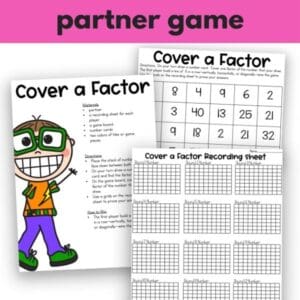
Station 2: Cover a Factor Math Game
- Materials Needed: Game board, number cards, 2 recording sheets, and 2 different colored game pieces.
- Instructions: Pair students up to play. They will draw a number card and cover one of the factors of that number on the game board.
- Goal: The objective is to make a line of 5 covered spaces horizontally, vertically, or diagonally. If students need more space than what the grid allows, they may turn the paper over and continue on the back.
NOTE: If you need a few reminders to keep the math game chaos to a minimum, download this free set of math game expectations posters!
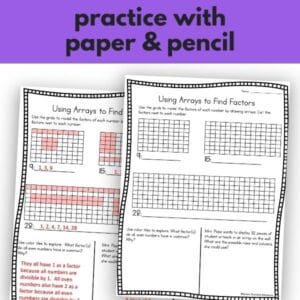
Station 3: Paper and Pencil Practice
- Materials Needed: Using Arrays to Find Factors worksheet.
- Instructions: Students complete the worksheet to reinforce their understanding of finding factors using arrays.
Using arrays to find factors is a hands-on, visual way to to get students working with multiplication and division concepts and it’s setting the stage for adding and subtracting fractions with unlike denominators. The mix of cooperative activities, small group instruction, and independent math stations will keep your studnets motivated to learn.
Feel free to share your own tips and tricks for teaching factors using arrays in the comments below. Let’s inspire each other!
If you’d like to see the full lesson plan and materials I use, you check them out here.

